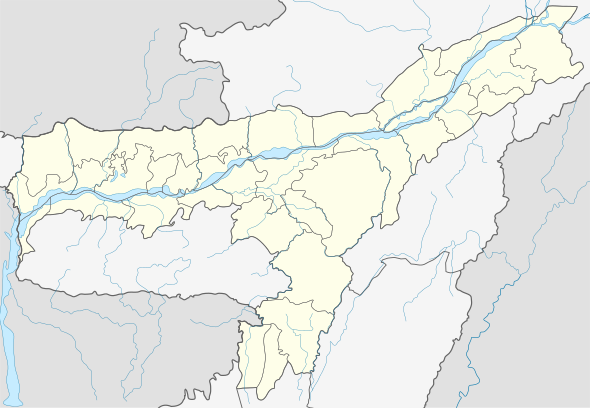North Kamrup massacre
North Kamrup massacre is part of Bongal Kheda movement in Assam, India.[1][2] In 1980, 3 January, violence broke out in Barikadanga village. Barikadanga village is about 10 miles from Nalbari. The violence was openly directed against linguistic, religio-linguistic, ethnic minorities of Assam and people opposed to the agitation.[1] Contemporary writtings are also reflects that.[1][2] The incident triggered by the death of a high school student, Dilip Huzuri, a member of the AASU, who went to spread anti-Bengali movement in Barikadanga village. That time there was a series of incidents in North Kamrup.[3]
| North Kamrup massacre | |
|---|---|
 | |
| Location | North Kamrup, Assam, India |
| Date | 3 January 1980 (UTC+5:30) |
| Target | Bengali speakers |
Attack type | Massacre and Ethnic cleansing |
| Weapons | Guns, spears, swords, scythes, bows and arrows |
| Perpetrators | Assamese mobs |
Anti-Bengali movement
During the partition of India that accompanied independence, communal violence took place on a large scale, trading on a historical anti-Bengali movement. In some districts of lower Assam, Bengali Hindus have experienced violence directed against on the linguistic and cultural identity of the Assamese people.[3]
Assam has been churned in the cauldron of communal, ethnic, and state violence in the name of Assam Movement during 1979 to 1985.[3] Some incidents of them are the North Kamrup pogrom of 1980 in which a large number of people belonging to the linguistic and religious minorities were massacred. In 1981 Khoirabari massacre sword down nearly 100 Bengali Hindus.[4][5] Similar massacres took place again in 1983 at Chaulkhowa Chapori and Silapathar[6][7] in 1983.
Background of the incident
The Bengali speaking immigrant were often harassed as foreigners and became the target of violence in the Carly phase of the anti-Bengali movement in Assam.[8] At the beginning of the movement, many Muslim students of East Bengal origin supported and joined the movement.[9] They were pretended themselves as Assamese speaker, called Na Asamiya.[lower-alpha 1][10][9] Although, after some years while Assamese speakers became the majority in Assam along with Muslims who pretended them as Assamese speaker, Assamese people started violence against Bengali speaker including Bengali Hindus. As soon as Muslim immigrants were diplomatically cheated by Assamese people and their community was targeted, they turned against anti-Bengali movement and slowly withdrew their support.[9]
Violence and victimisation
According to one version, on 3 January 1980, a group of students of Baganpara High School were visiting Barikadanga to supervise a three-day strike in response to a call given by the AASU for supporting the anti-Bengali movement.[8] According to another version, the students went there to raise money for the anti-Bengali movement. The village of Barikadanga has a mixed Hindu and Muslim Bangalee population, most of whom are immigrants. They attacked the students as students were there for spreading anti-Bengali movement.
Read also
References
Notes
- The term Na-Asamiya in Assamese language literally means new Assamese, the prefix Na- means new and Asamiya means Assamese. After the Partition of India, the group gave up its Bengali linguistic identity and adopted the Assamese language. Gradually they adopted Assamese culture like gamosa. In English, they are sometimes referred to as Neo-Assamese. Na-Asamiyas also referred to as Charua Musalman, literally meaning Muslims of the chars, because of their preference in settling in the chars.
Citations
- Desai, Akshayakumar Ramanlal (1986). Violation of Democratic Rights in India. Popular Prakashan. ISBN 9780861321308.
- Dutta, Nandana (2012-09-11). Questions of Identity in Assam: Location, Migration, Hybridity. SAGE Publications India. ISBN 9788132117001.
- Samaddar, Ranabir (2004-07-01). Peace Studies: An Introduction To the Concept, Scope, and Themes. SAGE Publications India. ISBN 9788132102878.
- Rammohan, E. N. (2005). Insurgent Frontiers: Essays from the Troubled Northeast. India Research Press. ISBN 9788187943808.
- Rammohun, E. M. (2011-12-29). Countering Insurgencies in India: An Insider's View. Vij Books India Pvt Ltd. ISBN 9789381411667.
- Basu, Sibaji Pratim (2009-02-01). The Fleeing People of South Asia: Selections from Refugee Watch. Anthem Press. ISBN 9781843317784.
- Bakshi, Shiri Ram; Sharma, Sita Ram; Gajrani, S. (1998). Contemporary Political Leadership in India: Sharad Pawar, the Maratha legacy. APH Publishing. ISBN 9788176480086.
- Bakshi, Shiri Ram; Sharma, Sita Ram; Gajrani, S. (1998). Contemporary Political Leadership in India: Sharad Pawar, the Maratha legacy. APH Publishing. ISBN 9788176480086.
- Kimura, Makiko (2013-09-03). The Nellie Massacre of 1983: Agency of Rioters. SAGE Publications India. ISBN 9788132116561.
- Bhaumik, Subir (April 2011). "Risk of durable disorder". Seminar. New Delhi: Seminar Publications (620). Retrieved 10 July 2017.